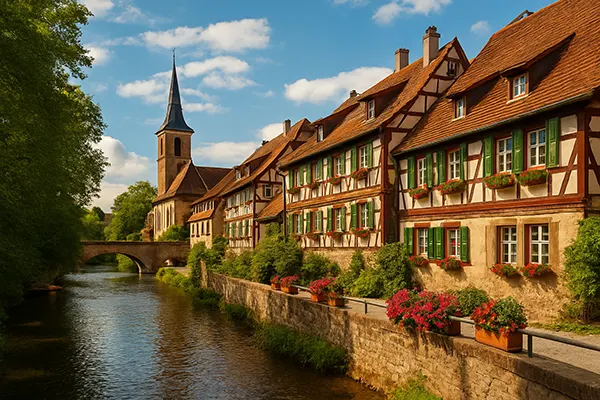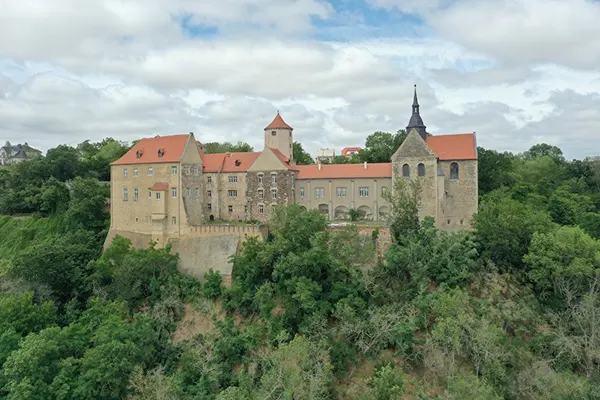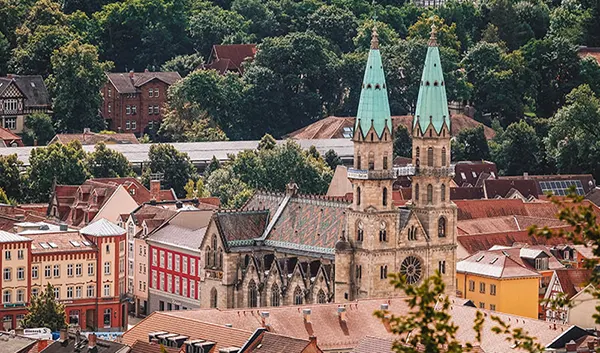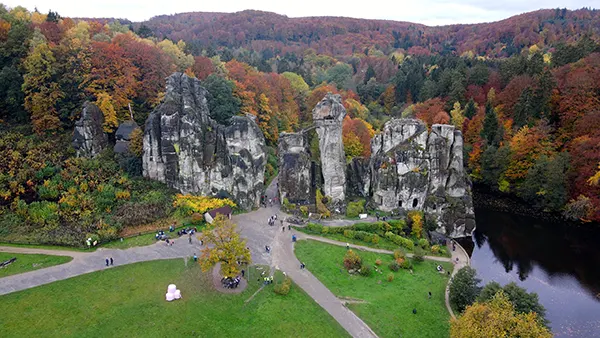
Externsteine – The Stone Forest of Westphalia: Germany’s Hidden Megaliths
In the heart of the Teutoburg Forest, hidden among dense woodland and far from the spotlight of mass tourism, stands a natural and historical monument unlike any other in Germany – the Externsteine. Often compared to Stonehenge, these towering sandstone pillars have sparked curiosity among geologists, historians, and spiritual seekers alike. Their ancient carvings and mysterious origins make the Externsteine a rare gem of Central Europe, revealing layers of natural beauty and cultural heritage.
Geological Origins and Unique Formations
The Externsteine were formed approximately 70 million years ago during the late Cretaceous period. Composed primarily of hardened sandstone, the formations were originally laid down horizontally but were later pushed upward by tectonic forces, creating vertical pillars up to 40 metres high. These dramatic structures are part of the Osning ridge and appear to rise out of the earth like ancient guardians of time.
What makes these rock formations especially fascinating is their rare vertical alignment, which is uncommon for sedimentary rock. Wind and water erosion sculpted the stones over millions of years, resulting in a variety of spires, caves, and natural ledges that now dominate the landscape. Today, this geotope is not only protected but also celebrated for its scientific significance and aesthetic appeal.
Climbers, hikers, and scholars frequent the area, drawn not only by the formations themselves but also by the panoramic views they offer of the Teutoburg Forest region. The site’s preservation has become a local priority, with regulated access ensuring both ecological integrity and visitor safety.
Ancient Carvings and Cultural Significance
Beyond its geological marvels, the Externsteine are adorned with intricate reliefs and carvings believed to date back to the early medieval period. The most famous among them is the “Descent from the Cross,” a Christian scene etched into the sandstone, likely in the 12th century. It is one of the oldest known rock reliefs in Central Europe and has stirred considerable debate about its origin and symbolism.
Some historians believe the site had religious importance long before Christianity took root. Pagan rituals were likely conducted here, supported by the positioning of chambers and stone altars. The spiritual aura of the site continues to draw modern-day neo-pagans and mystics who view the stones as a place of power and connection to nature’s energies.
The combination of early Christian iconography and older ritualistic traces reflects Germany’s transition from ancient pagan cultures to Christian dominance. This juxtaposition provides a rare glimpse into how sacred sites were reinterpreted and repurposed across different historical periods.
Externsteine in Modern German Culture
Today, the Externsteine hold a unique place in German national consciousness. While not as internationally recognised as Neuschwanstein Castle or Cologne Cathedral, the rocks have inspired countless artists, writers, and thinkers. In the 18th and 19th centuries, Romantic poets and painters captured the site’s atmospheric qualities, further embedding it in cultural memory.
During the 20th century, the stones gained controversial attention due to their appropriation by nationalist ideologies, particularly during the Nazi era. Heinrich Himmler’s Ahnenerbe organisation conducted archaeological excavations here, hoping to link the site to an Aryan mythos. This chapter remains a sensitive topic but also underscores the symbolic power that natural landmarks can accrue over time.
In contrast, the 21st-century perspective has returned focus to heritage conservation and tourism. Regional authorities promote the Externsteine as part of the Hermannsweg hiking trail, drawing thousands of visitors annually while emphasising the site’s natural and historical value over ideological narratives.
Accessibility and Visitor Experience
Externsteine is located near the town of Horn-Bad Meinberg in North Rhine-Westphalia and is accessible by regional train and bus services. The site features marked paths, information panels, and a small visitor centre that offers educational materials on the geology and history of the stones.
Visitors can climb metal stairways fixed into the rock, reaching viewing platforms that offer sweeping views over the Teutoburg Forest. While the climb is not strenuous, it is not suitable for individuals with reduced mobility. There are also picnic areas, guided tours, and seasonal events focusing on folklore and astronomy.
Importantly, access to the main parts of the formation is regulated to protect the delicate rock surfaces from erosion. The site is managed by the Landschaftsverband Westfalen-Lippe (LWL), which ensures that tourism remains sustainable and respectful of its cultural importance.
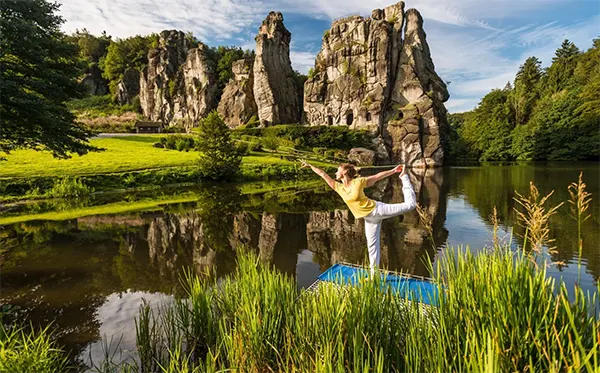
Externsteine’s Role in Nature and Science
Apart from its cultural significance, the Externsteine also play an important role in local biodiversity. The surrounding forest is home to numerous species of birds, bats, and plants, many of which are protected under regional conservation laws. The area is designated as a nature reserve and supports various ecological studies.
The interplay of sunlight and shadow on the rocks has also attracted interest from archaeoastronomers. Some believe the stones were used to observe solstices and equinoxes in prehistoric times, based on the alignment of certain crevices and notches. Though not universally accepted, this theory adds yet another layer of intrigue to the site.
Environmental scientists have also monitored the sandstone’s weathering patterns to understand climate impact over time. As such, Externsteine serves as a natural laboratory for researchers, providing insights into erosion, sedimentary history, and ecological resilience.
Why Externsteine Deserves Wider Recognition
Despite its multifaceted appeal, Externsteine remains relatively unknown outside of Germany. Its remote location and understated promotion mean that many tourists miss this extraordinary site altogether. However, for those interested in off-the-beaten-path travel, it offers a rich blend of geology, spirituality, and national heritage.
The site exemplifies how natural monuments can transcend their physical presence to become cultural symbols. It stands as a testament to the enduring relationship between humanity and the landscape – one that spans millennia of belief, adaptation, and discovery.
Efforts are ongoing to include the Externsteine in UNESCO’s list of World Heritage Sites. Such recognition would not only safeguard its future but also elevate its profile as one of Europe’s truly unique natural and historical landmarks.

